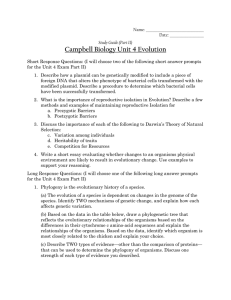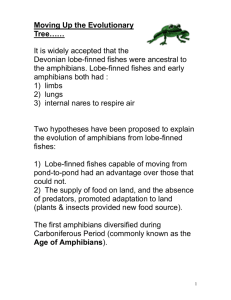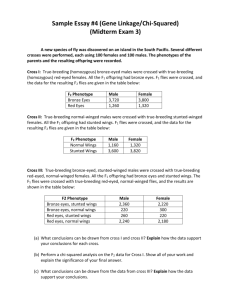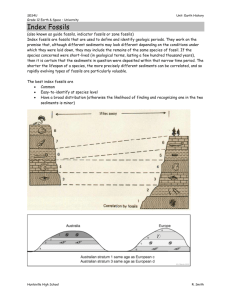short answer questions
advertisement
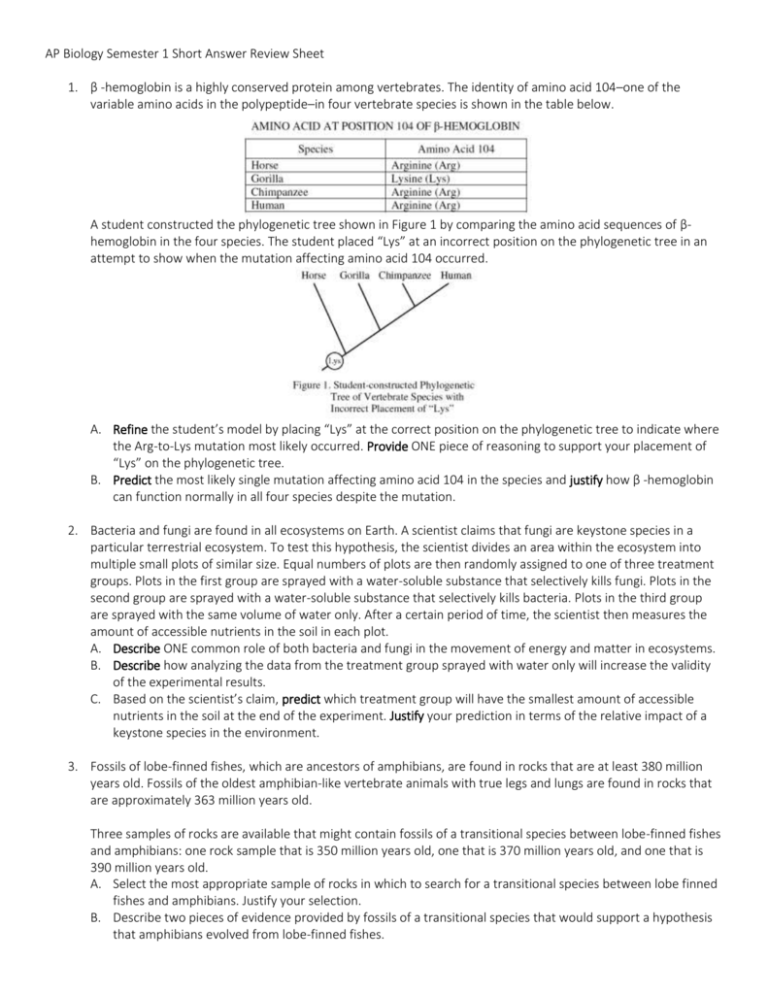
AP Biology Semester 1 Short Answer Review Sheet 1. β -hemoglobin is a highly conserved protein among vertebrates. The identity of amino acid 104–one of the variable amino acids in the polypeptide–in four vertebrate species is shown in the table below. A student constructed the phylogenetic tree shown in Figure 1 by comparing the amino acid sequences of βhemoglobin in the four species. The student placed “Lys” at an incorrect position on the phylogenetic tree in an attempt to show when the mutation affecting amino acid 104 occurred. A. Refine the student’s model by placing “Lys” at the correct position on the phylogenetic tree to indicate where the Arg-to-Lys mutation most likely occurred. Provide ONE piece of reasoning to support your placement of “Lys” on the phylogenetic tree. B. Predict the most likely single mutation affecting amino acid 104 in the species and justify how β -hemoglobin can function normally in all four species despite the mutation. 2. Bacteria and fungi are found in all ecosystems on Earth. A scientist claims that fungi are keystone species in a particular terrestrial ecosystem. To test this hypothesis, the scientist divides an area within the ecosystem into multiple small plots of similar size. Equal numbers of plots are then randomly assigned to one of three treatment groups. Plots in the first group are sprayed with a water-soluble substance that selectively kills fungi. Plots in the second group are sprayed with a water-soluble substance that selectively kills bacteria. Plots in the third group are sprayed with the same volume of water only. After a certain period of time, the scientist then measures the amount of accessible nutrients in the soil in each plot. A. Describe ONE common role of both bacteria and fungi in the movement of energy and matter in ecosystems. B. Describe how analyzing the data from the treatment group sprayed with water only will increase the validity of the experimental results. C. Based on the scientist’s claim, predict which treatment group will have the smallest amount of accessible nutrients in the soil at the end of the experiment. Justify your prediction in terms of the relative impact of a keystone species in the environment. 3. Fossils of lobe-finned fishes, which are ancestors of amphibians, are found in rocks that are at least 380 million years old. Fossils of the oldest amphibian-like vertebrate animals with true legs and lungs are found in rocks that are approximately 363 million years old. Three samples of rocks are available that might contain fossils of a transitional species between lobe-finned fishes and amphibians: one rock sample that is 350 million years old, one that is 370 million years old, and one that is 390 million years old. A. Select the most appropriate sample of rocks in which to search for a transitional species between lobe finned fishes and amphibians. Justify your selection. B. Describe two pieces of evidence provided by fossils of a transitional species that would support a hypothesis that amphibians evolved from lobe-finned fishes. 4. The following data were collected by observing subcellular structures of three different types of eukaryotic cells. Based on an analysis of the data, identify a likely primary function of each cell type and explain how the data support the identification. 5. The Figure above represents a generalized hormone-signaling pathway. Briefly explain the role of each numbered step in the regulating target gene expression 6. In fruit flies (Drosophila melanogaster), straight wing shape is dominant to curly wing shape. A particular population of fruit flies is in Hardy-Weinberg equilibrium with respect to the alleles for wing shape. The Hardy-Weinberg equation, given below, is useful in understanding population genetics: p2 + 2pq + q2 = 1 2 2 A. Explain what the terms (p , 2pq, and q ) represent in the population of fruit flies. B. Describe one condition that is necessary for the population to be in equilibrium. 7. Fruit flies (Drosophila melanogaster) with a wild-type phenotype have gray bodies and red eyes. Certain mutations can cause changes to these traits. Mutant flies may have a black body and/or cinnabar eyes. To study the genetics of these traits, a researcher crossed a true-breeding wild-type male fly (with gray body and red eyes) with a true-breeding female fly with a black body and cinnabar eyes. All of the F1 progeny displayed a wild-type phenotype. Female flies from the F1 generation were crossed with true-breeding male flies with black bodies and cinnabar eyes. The table below represents the predicted outcome and the data obtained from the cross. Explain the difference between the expected data and the actual numbers observed. 8. Fossils of a microscopic organism are found in rocks determined to be over 3.5 billion years old. Identify TWO types of evidence that would help answer the question of whether the organism was photosynthetic.
